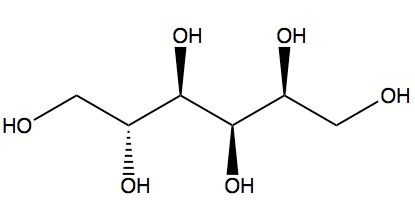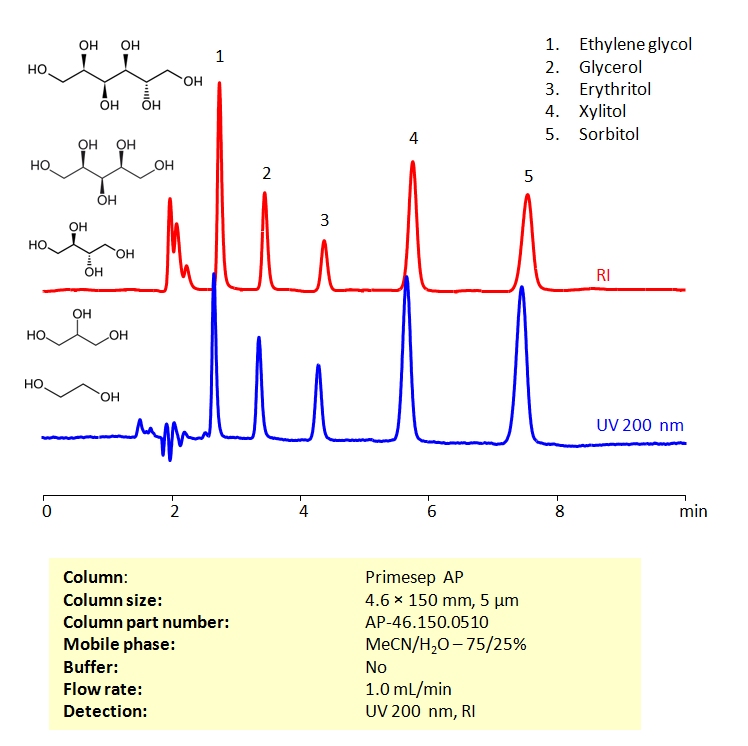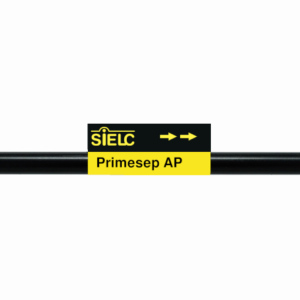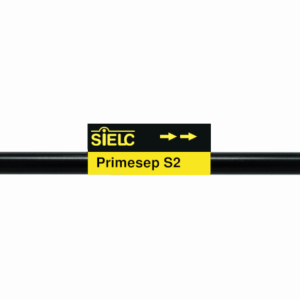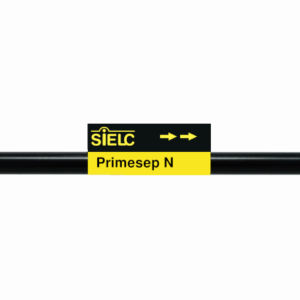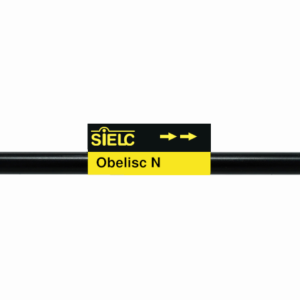| CAS Number | 50-70-4 |
|---|---|
| Molecular Formula | C6H14O6 |
| Molecular Weight | 182.172 |
| InChI Key | FBPFZTCFMRRESA-JGWLITMVSA-N |
| LogP | -2.20 |
| Synonyms |
|
Applications:
HPLC Method For Simultaneous Quantification of Sugar Alcohols (Polyols) on Primesep AP
September 9, 2021
HPLC Method for Glycerol, Xylitol, Sorbitol, Erythritol, Ethylene Glycol on Primesep AP by SIELC Technologies
High Performance Liquid Chromatography (HPLC) Method for Analysis of Glycerol, Xylitol, Sorbitol, Erythritol, Ethylene Glycol.
Ethylene glycol is an organic compound with the formula (CH2OH)2. It has a variety of uses, but it is primarily found as an antifreeze agent. Those coolants are often used in automobiles and air-conditioning systems. In the plastic industry, ethylene glycol is a precursor to polyester fibers and resins.
Glycerol is an organic compound with the molecular formula C3H8O3. It is a humectant, solvent, and sweetener that used in various industries including skin care, hygiene products, pharmaceuticals, and food. It is said to improve lubrication and smoothness in products. Historically, before ethylene glycol took over, glycerol was used as a antifreeze.
Erythritol is a naturally accruing sugar alcohol with the chemical formula C4H10O4. It is is typically used as a sweetener and flavor enhancer in a large variety of foods and bevarages, including but not limited to tea, juice blends, soft drinks, cookies, biscuits, sugar-free chewing gum, and confections. It does lead to a noticeably different texture in baked products if used as a sugar replacement.
Xylitol is a sugar alcohol with the chemical formula C5H12O5. It is primarily used as a sugar supplement in confections, toothpaste, and drugs. It is considered a safe option for those with diabetes as it has negligible effects on blood sugar. It is said to produce a cooling sensation when interacting with moisture, which makes it an interesting additive to textiles.
Sorbitol is a sugar alcohol with the chemical formula C6H14O6. It is used primarily as a sugar substitute, but it also provides some dietary energy. Medically, it can be used as a laxative. In modern cosmetics, it is also used as a humectant and thickener.
Glycerol, Xylitol, Sorbitol, Erythritol, Ethylene Glycol can be retained and analyzed using the Primesep AP stationary phase column. The analysis utilizes an isocratic method with a simple mobile phase consisting of water and acetonitrile (MeCN). Detection is performed using UV.
| Column | Primesep AP, 4.6 x 150 mm, 5 µm, 100 A, dual ended |
| Mobile Phase | MeCN/H2O – 75/25% |
| Buffer | No |
| Flow Rate | 1.0 ml/min |
| Detection | UV 200 nm, RI |
| Class of Compounds |
Drug, Basic, Hydrophobic, Ionizable, Zwitterionic |
| Analyzing Compounds | Glycerol, Xylitol, Sorbitol, Erythritol, Ethylene Glycol |
Application Column
Primesep AP
Column Diameter: 4.6 mm
Column Length: 150 mm
Particle Size: 5 µm
Pore Size: 100 A
Column options: dual ended
Ethylene Glycol
Glycerol
Sorbitol
Xylitol

HPLC Separation of Sugars on Primesep S2 Column
July 14, 2011
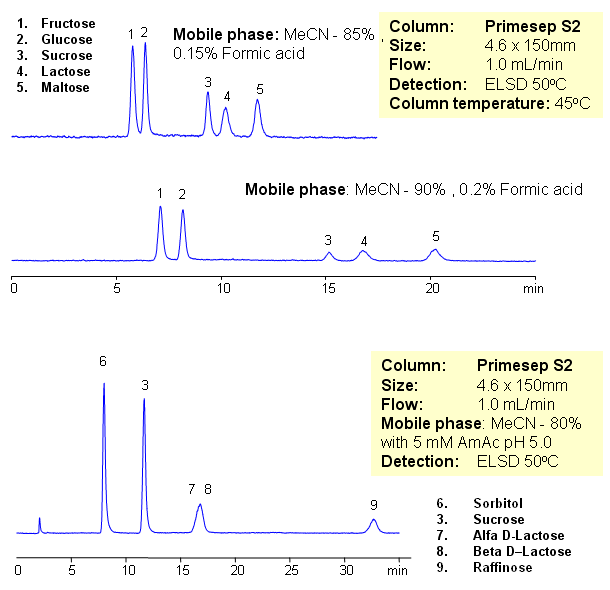
Five sugars were separated on a Primesep S2 HILIC column with LC/MS compatible conditions. Various mobile phase produce different selectivity and separation. Method can be used as alternative to aminopropyl column. Primesep S2 column is stable and does not undergo rapid hydrolysis like aminopropyl columns.
| Column | Primesep S2, 4.6×150 mm, 5 µm, 100A |
| Mobile Phase | MeCN/H2O |
| Buffer | AmAc pH 5.0, Formic Acid |
| Flow Rate | 1.0 ml/min |
| Detection | ELSD 50C |
| Class of Compounds |
Drug, Acid, Monocarboxylic acid, Hydrophilic, Ionizable, Hormone |
| Analyzing Compounds | Fructose, Glucose, Sucrose, Lactose, Maltose, Sorbitol, Sucrose, Alfa D-Lactose, Beta D–Lactose, Raffinose |
Application Column
Primesep S2
The Primesep family of mixed-mode columns offers a wide variety of stationary phases, boasting unprecedented selectivity in the separation of a broad array of chemical compounds across multiple applications. Corresponding Primesep guard columns, available with all stationary phases, do not require holders. SIELC provides a method development service available to all customers. Inquire about our specially-tailored custom LC-phases for specific separations.
Select optionsGlucose
Lactose
Maltose
Raffinose
Sorbitol
Sucrose
alpha-D-Lactose
beta-D-Lactose

HPLC Separation of Saccharin and Sorbitol
October 14, 2010
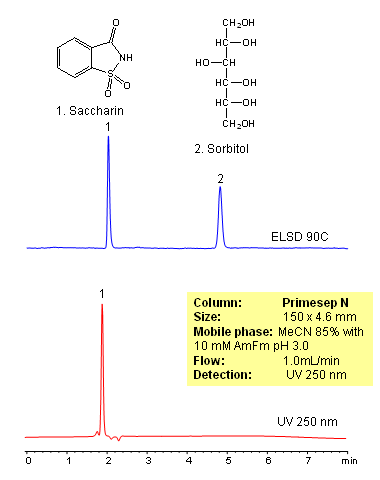
Sorbitol and saccharin are two sugar substitutes used in food and drinks. Separation of sorbitol and saccharin was achieved on a Primesep N HILIC column using acetonitrile/water with ammonium formate. Compounds were monitored by combination of UV and ELSD. Method is compatible with LC/MS detection.
Application Column
Primesep N
The Primesep family of mixed-mode columns offers a wide variety of stationary phases, boasting unprecedented selectivity in the separation of a broad array of chemical compounds across multiple applications. Corresponding Primesep guard columns, available with all stationary phases, do not require holders. SIELC provides a method development service available to all customers. Inquire about our specially-tailored custom LC-phases for specific separations.
Select optionsSorbitol

HILIC Separation of Sugars on Obelisc N
March 3, 2010
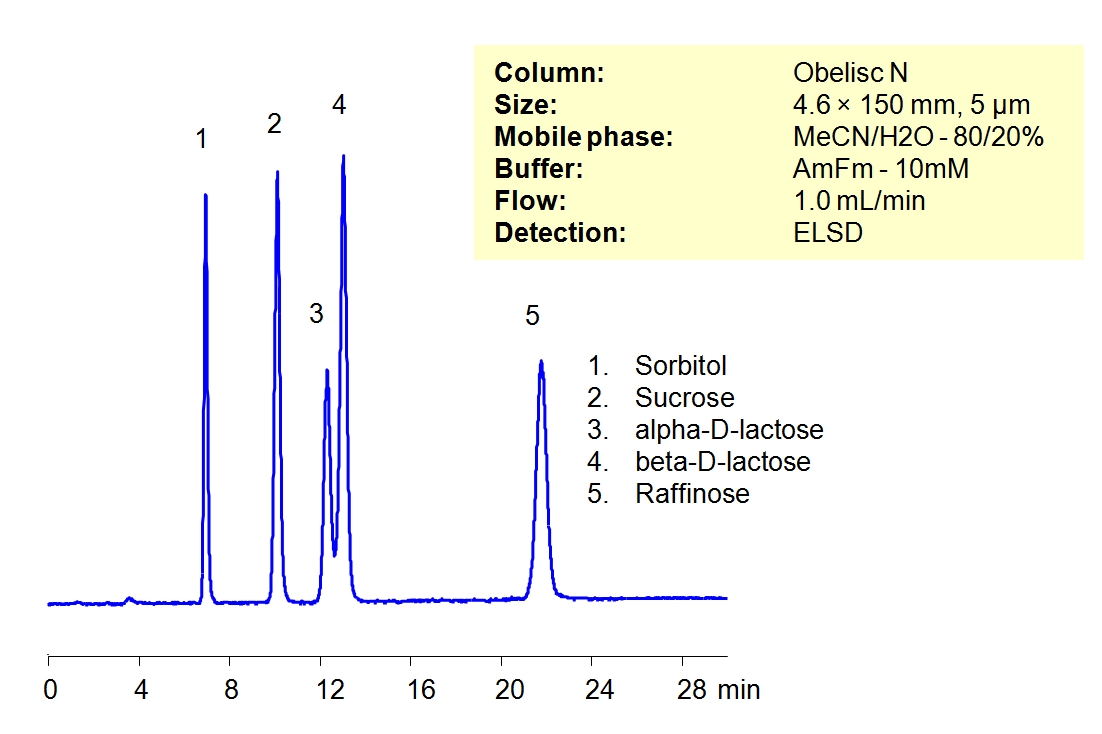
Common sugars can be separated on an Obelisc N HILIC/cation-exchange column with LC/MS compatible mobile phase. Highly polar surface of Obelisc N column provides good retention for sorbitol, sucrose, lactose and raffinose. Other sugars can be separated using this column.
| Column | Obelisc N, 4.6×150 mm, 5 µm, 100A |
| Mobile Phase | MeCN/H2O |
| Buffer | AmFm |
| Flow Rate | 1.0 ml/min |
| Detection | ELSD |
| Class of Compounds |
Hydrophilic, Ionizable, Sugars |
| Analyzing Compounds | Sorbitol, Sucrose, Lactose, Raffinose |
Application Column
Obelisc N
SIELC has developed the Obelisc™ columns, which are mixed-mode and utilize Liquid Separation Cell technology (LiSC™). These cost-effective columns are the first of their kind to be commercially available and can replace multiple HPLC columns, including reversed-phase (RP), AQ-type reversed-phase, polar-embedded group RP columns, normal-phase, cation-exchange, anion-exchange, ion-exclusion, and HILIC (Hydrophilic Interaction Liquid Chromatography) columns. By controlling just three orthogonal method parameters - buffer concentration, buffer pH, and organic modifier concentration - users can adjust the column properties with pinpoint precision to separate complex mixtures.
Select optionsSorbitol
Sucrose
alpha-D-Lactose
beta-D-Lactose

